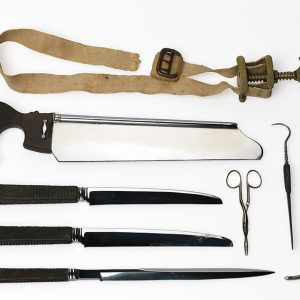calsfoundation@cals.org
Civil War Medicine
Medical treatment during the Civil War focused on two major areas: disease and wound care. As many as 700,000 members of the military lost their lives during the war, and approximately two-thirds of these deaths were due to disease. These figures do not include deaths suffered by the civilian population. Diseases were common before the war, especially yellow fever, cholera, and typhoid, but the war magnified their effect and sometimes brought them to epidemic proportions.
The outbreak of war led to a massive mobilization effort in the state. Thousands of men joined military units and moved into camps with limited sanitary facilities. This lack of clean water, coupled with the large numbers of men living in close proximity, led to massive outbreaks of disease. In many cases, recruits from rural areas were more susceptible to common childhood diseases than their urban counterparts simply due to a lack of exposure. Camp Nelson near Cabot (Lonoke County) housed thousands of Confederate troops from Arkansas and Texas in 1862 before being struck by a number of epidemics. Measles, mumps, typhoid, and other diseases ran through the camp, leading to the deaths of around 1,500 men, including Brigadier General Allison Nelson. The camp was soon abandoned.
Federal units also faced disease. After the Battle of Pea Ridge, the Army of the Southwest marched across southern Missouri and northern Arkansas in an effort to take Little Rock (Pulaski County). Unable to do so at that time, the army instead captured Helena (Phillips County) due to its strategic location along the Mississippi River. As the Federal army crowded into the town, it was joined by hundreds of newly freed slaves. Many waterborne diseases and illnesses that were spread through mosquitoes swept through the army due to a lack of sanitation in the camps. Standing water near camps and the failure of authorities to ensure that drinking water was free from containments in part led to the spread of disease. A hospital was established in the city but could not treat the growing number of sick men. Federal military surgeons who were trained to handle battlefield casualties were ill-prepared to treat the large numbers of soldiers suffering from diseases.
Battlefield casualties made up a much smaller number of deaths during the war. In Arkansas, more than 182,000 white Federal troops became infirm due to disease or injury during the war. Only about 4,500 of these infirmities were directly related to wounds, accidents, and other injuries; the remaining infirmities were from illness. Some 2,348 men suffering from illness died during the war in the state. These numbers do not include troops who died after being evacuated to other states. Confederate numbers are more difficult to ascertain due to both the lack of record keeping and the loss of records that were kept at the time.
Union infantry regiments were organized with a surgeon, at least one assistant surgeon, and hospital stewards. After initial confusion at the beginning of the war, most surgeons who served in the state had at least some medical training and were able to pass a test administered by the Army Medical Corps. Casualties suffered in battle were often treated in field hospitals close to the battlefield where the injury occurred before being transferred to general hospitals in more-secure locations. Federal hospitals in Little Rock, DeValls Bluff (Prairie County), Fort Smith (Sebastian County), Pine Bluff (Jefferson County), and Helena treated the majority of Union casualties. Little Rock had three hospitals, divided into a general, officers’, and “colored.” Major hospitals in Memphis, Tennessee, and St. Louis, Missouri, also treated many casualties from Arkansas. While hospitals for African-American troops were constructed in other southern-occupied cities, Helena had only a single general hospital. The nearest hospital for United States Colored Troops (USCT) members was in DeValls Bluff, more than seventy miles away from Helena by land. Helena transferred many patients up the Mississippi River to Memphis.
USCT troops died from disease at a rate more than five times that experienced by white troops. A lack of surgeons and other trained medical personnel led to higher rates of disease and death in USCT units, especially as many in USCT units served their entire careers without ever receiving a surgeon assigned to their ranks. Surgeons and assistant surgeons assigned to USCT units were ineligible to serve in staff positions, preventing advancement through the ranks. By the time USCT units were organized, few trained medical professionals remained who desired to serve in the military, and a lack of opportunity for advancement led many to turn down a position with a black regiment.
Confederate units also used surgeons and hospital stewards to care for the sick and wounded troops. The general hospital in Little Rock operated at St. Johns’ College and in the Rock Hotel. After the Battle of Shiloh, eight more hospitals were opened in the city, many in churches. During the Little Rock Campaign—in which the Union army maneuvered Confederate troops out of the Arkansas capital, thus returning it to Federal control in 1863—only one hospital remained open in the city, but approximately half of the Confederate troops in the capital were unavailable for duty due to illness. (Thousands of Federal troops in the campaign were also sick, causing a strain on Union supply lines.) Many sick Confederates were evacuated with the army as it retreated to the southwest.
After the fall of Little Rock to the Union in September 1863, small hospitals were established in Washington (Hempstead County), Magnolia (Columbia County), and Camden (Ouachita County). After the Engagement at Jenkins’ Ferry, Confederate hospitals were established at Tulip (Dallas County) and Princeton (Dallas County) to help care for the large number of wounded troops. As troops’ health improved, they were moved to other general hospitals at Washington and Magnolia. Military necessity often required armies to leave wounded troops behind under the care of a surgeon. After the Battle of Helena, 168 wounded men were left at a house near the city as the Confederate army retreated. Captured by Union forces on July 6, 1863, the wounded troops were paroled while the medical staff members were allowed to continue their care. The hospital remained open for more than a month as the wounded recovered, were transferred to other hospitals, died, or were replaced by newly sick and wounded troops. While the medical expertise of the surgeons would be seen as primitive by today’s standards, surgeons worked together to discuss and learn from their cases in order to improve their treatment efforts.
With many doctors serving with the military, medical service was often difficult for civilians to obtain. Both armies treated civilians when necessary, and Federal surgeons were also tasked with caring for some of the freedmen who fled to Union lines. Surgeons on both sides were allowed to continue their private practices for pay while also serving in the army.
The impact of disease and other medical problems on both armies during the Civil War cannot be understated. With large numbers of troops ill from disease and inadequate medical care, military operations in the state suffered. During the campaign to take Little Rock in the summer of 1863, around 1,000 Federal troops out of 7,000 became ill during a march between Helena and Clarendon (Monroe County), a distance of less than fifty miles. During the expedition, about twelve percent of the Union force was sick at any given time. Virtually all of the deaths suffered in Unionist Arkansas units came from illnesses. Resources were used to care for ill troops and evacuate them to hospitals in other states, undercutting the effectiveness of both sides in the war.
For additional information:
Adams, George W. Doctors in Blue: The Medical History of the Union Army in the Civil War. New York: Collier, 1961.
Bell, Andrew. Mosquito Soldiers: Malaria, Yellow Fever, and the Course of the American Civil War. Baton Rouge: Louisiana State University Press, 2010.
Breckenridge, Mary E. “Adventures on a Hospital Boat on the Mississippi.” Phillips County Historical Quarterly 1 (December 1962): 31–42.
Cunningham, H. H. Doctors in Gray: The Confederate Medical Service. Baton Rouge: Louisiana State University Press, 1993.
Elsas, Fredrick J. “The Journal of Henry L. Dye, Confederate Surgeon.” Surgery 63 (February 1968): 352–362.
Denney, Robert E. Civil War Medicine: Care and Comfort of the Wounded. New York: Sterling, 1994.
Duncan, Louis C. The Medical Department of the United States Army in the Civil War. Gaithersburg, MD: Olde Soldier Books, 1987.
Finley, Randy. “In War’s Wake: Health Care and the Arkansas Freedman, 1863–1868.” Arkansas Historical Quarterly 51 (Summer 1992): 135–163.
Freemon, Frank R. Gangrene and Glory: Medical Care during the American Civil War. Madison, NJ: Fairleigh Dickinson University Press, 1998.
Kellum, Rachel M. “Surgeons of the Severed Limb: Confederate Military Medicine in Arkansas, 1863–1865.” MA thesis, Jackson College of Graduate Studies, 2014.
Otis, G. A., and D. L. Huntington, eds. Medical and Surgical History of the Rebellion. Washington DC: Government Printing Office, 1883.
Pitcock, Cynthia D., and Bill J. Gurley, eds. I acted from Principle: The Civil War Diary of Dr. William M. McPheeters, Confederate Surgeon in the Trans-Mississippi. Fayetteville: University of Arkansas Press, 2002.
Steiner, Paul E. Disease in the Civil War: Natural Biological Warfare in 1861–1865. Springfield, IL: Charles C Thomas, 1968.
Wilson, J. Woodfin. “Some Aspects of Medical Services in the Trans-Mississippi Department of the Confederate States of America, 1863–1865.” Journal of the North Louisiana Historical Association 12 (1981): 123–146.
David Sesser
Henderson State University
 Civil War through Reconstruction, 1861 through 1874
Civil War through Reconstruction, 1861 through 1874 Health and Medicine
Health and Medicine Hospitals (Civil War)
Hospitals (Civil War) Civil War Surgical Instruments
Civil War Surgical Instruments  St. Johns College and U.S. Hospital
St. Johns College and U.S. Hospital 




Comments
No comments on this entry yet.